Work on the construction of the Huddersfield Narrow Canal began in 1794. The direct route chosen involved a daring plan for a tunnel more than 3 miles long under the Pennines at Standedge - longer than any other canal tunnel. The canal was due to open five years after work on it had begun. However, when 1799 arrived, while the canal had been constructed to Marsden and Dobcross on each side of the tunnel, the tunnel itself was far from open.
In the age of "Canal Mania" the desire for profit sometimes pushed the bounds of what was technically feasible at that time. A proposal by a rival to the Rochdale Canal Company for a four-mile tunnel between Littleborough and Ripponden never got beyond the drawing board. Standedge Tunnel was so ambitious that it nearly led to the downfall of the whole canal scheme.
The construction of the tunnel was beset by many problems, many of these being due to poor organisation. The excavation of the tunnel began at both ends but after a while it was realised that the Diggle end was being constructed several feet higher than the Marsden end.
In correcting this, previous work was undermined, causing several collapses. There was also a persistent problem of large quantities of water seeping into the workings and in one year only 150 yards of tunnel was excavated.
The canal's engineer, Benjamin Outram, had many other commitments so that most of the canal construction had taken place under the supervision of a young, inexperienced surveyor, Nicholas Brown. Some of the construction work elsewhere on the canal was inadequate and was washed away by floods in 1799. This and the tunnel's poor progress almost caused the project to be abandoned.
More capital was raised and repairs carried out, but the company desperately needed the revenue from carrying goods, so a system was set up of transporting cargo by horse between Marsden and Dobcross on the two completed sections of canal.
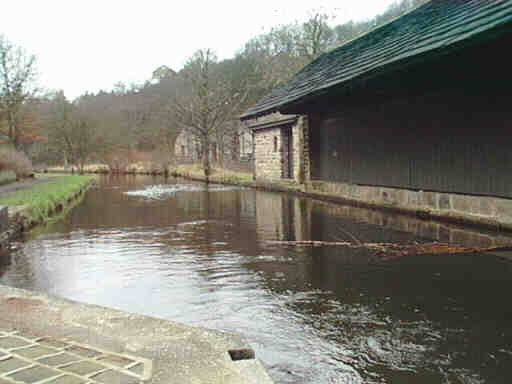
Transhipment warehouse at Dobcross.
On the right is the transhipment warehouse at Wool Road, Dobcross. Goods were unloaded here to be carried by horse over the hill to Marsden.
Following Outram's resignation, the well known engineer Thomas Telford was called in to advise on the tunnel's completion.
Excavation had been taking place, not only from each end, but also from the bottom of the air shafts. (The spoil was hoisted up the shafts and dumped nearby, where it can still be seen.) This led to the tunnel being somewhat crooked and Telford discovered that, at one point, the two excavations were not going to meet and that if they were not careful they were going to end up with two tunnels! Correcting this has resulted in the tunnel having noticeable bends!
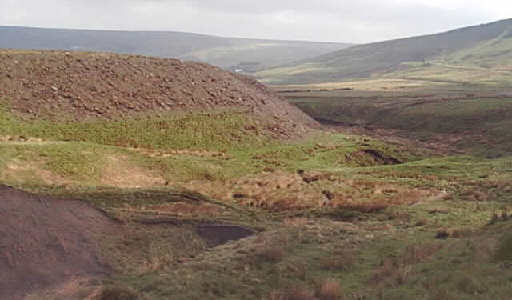
Spoil Heaps at Red Brook, Standedge.
Spoil heaps from the tunnel excavations at Red Brook, near the Great Western Hotel on Standedge.
The tunnel was eventually opened in 1811 and the canal became a through route 17 years after work began. The first boat through Standedge Tunnel, "Lively Lady" emerged to the sound of church bells and a band playing "Rule Britannia".
Using the tunnel wasn't an easy option for the boatmen, however. To keep costs down, the canal was built without a towpath. While the horses were led over the hill, the boatmen had to "leg" the boat through the tunnel, by lying on boards across the front of the boat and walking along the walls or roof of the tunnel, which took up to four hours
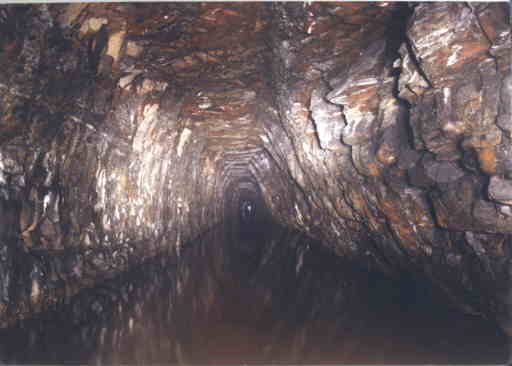
(Photo: Huddersfield Canal Society)
Much of the tunnel is brick lined, but the photograph above shows that parts of the tunnel are unlined with the surface being the hewn rock face, which would have made difficult work for the leggers.
The tunnel was only wide enough for one boat. There were several passing places big enough for single boats to pass, but as the traffic increased and with time meaning money for the boat crews, there were frequent fights as crews refused to back off.
The Canal Company decided that boats could only be propelled through the tunnel by its own official "leggers," and to operate a traffic control system. This involved only westbound traffic using the tunnel for a four hour period, then only eastbound during the next four hours. The tunnel thus became a bottleneck with boats having to queue to use the locks. The leggers were accommodated in Tunnel End Cottages and were paid a shilling a trip.
It took a long time for the canal's backers to to recover their investment and make any profit. After a short period of relative prosperity, the canal and tunnel were bought by the Huddersfield and Manchester Railway Company, whose line was to follow a similar route to the canal.
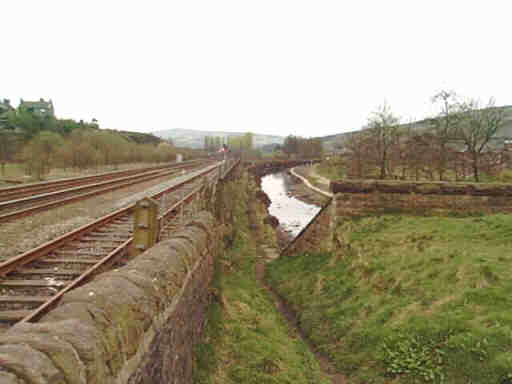
Tunnel entrance at Diggle.
The tunnel entrance at Diggle was extended outwards by 200 yards in 1894 to allow additional railway tracks to be constructed over the line of the canal.
The railway company wanted to use the canal to remove spoil from the excavations for their own tunnel, which ran alongside the canal tunnel. They did this by boring short connecting passages so that boats could be loaded with spoil.
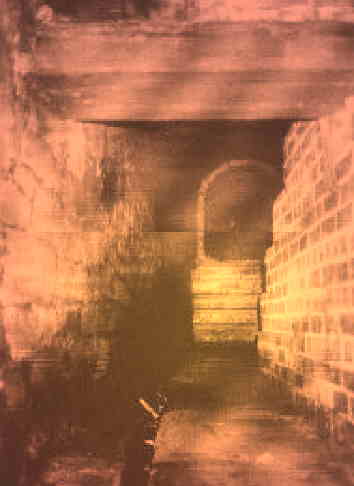
Interconnecting adit or side passage in Standedge Tunnel viewed from the canal tunnel. The original railway tunnel is beyond the doorway. The steps doubling back to the right lead across the canal tunnel to the rail tunnel used today. (Photo: Ken Wright)
With the railways taking traffic away from the canals, the Huddersfield Canal fell into slow decline. The last commercial boat passed through the tunnel in 1921. The canal was officially closed in 1944 although a boat, "Ailsa Craig", struggled through in 1948, being the last boat to make a complete passage along the canal before the lock gates were removed in the 1950s.
A maintenance boat remained on the summit level for carrying out inspections and basic maintenance within Standedge Tunnel. In 1961 and 1962 this boat took groups of canal enthusiasts through the tunnel. In time, however, parts of the roof became unstable and some sections collapsed, making navigation impossible.
By the time funding eventually became available to restore the tunnel, it had become a major operation, with some sections needing to be stabilised with rock bolts and others to be lined with concrete. 10,000 tons of silt and 3,000 tons of fallen rocks had to be removed. (See "Restoration" page for pictures of this work.)
On May 1st, 2001 the tunnel was open to boats once more, after restoration costing more than five million pounds. When the tunnel was originally opened in 1811,the cost of construction had been £123,804!
Click here to see pictures of the first boats through the restored tunnel.